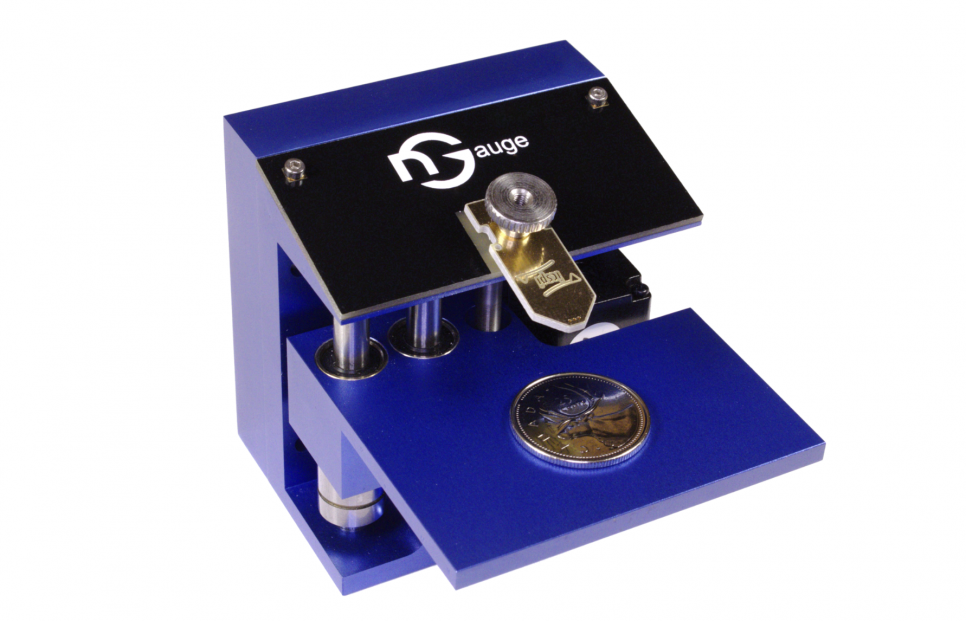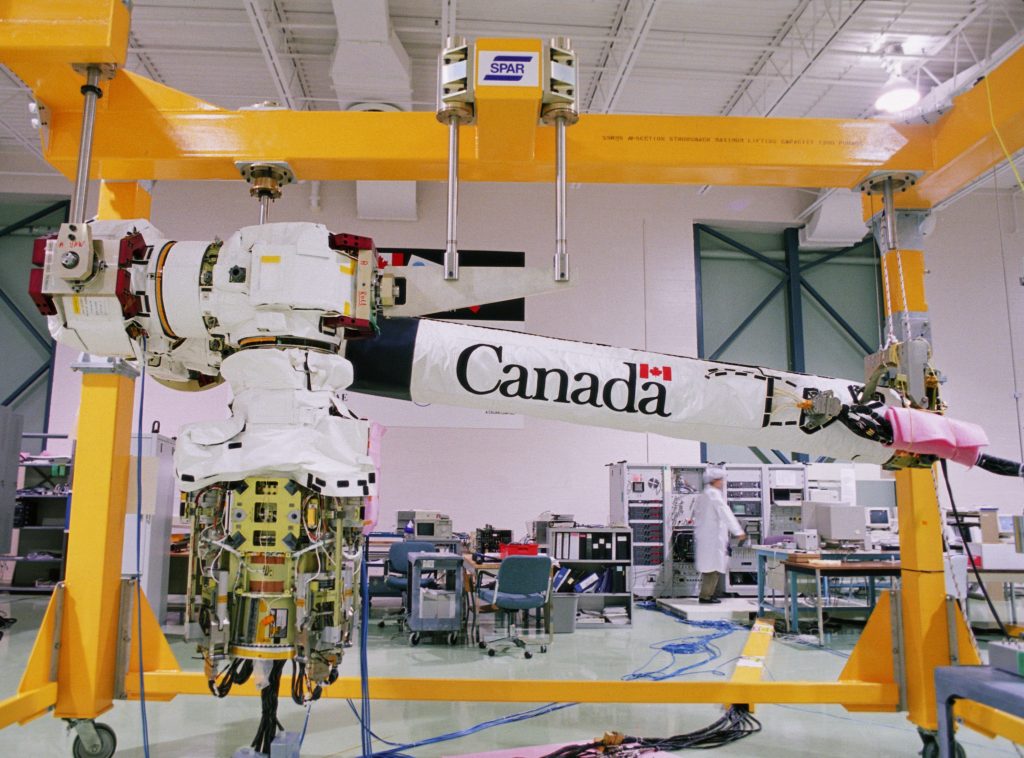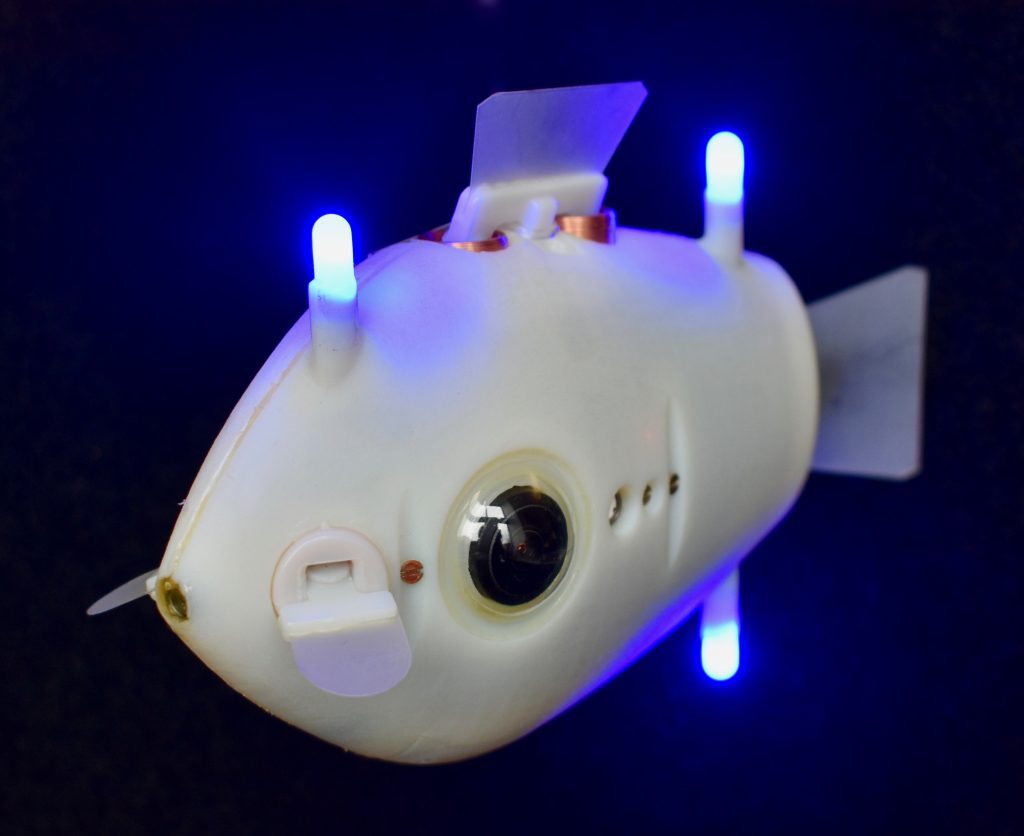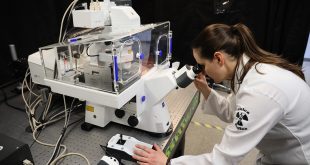As we all know too well, last year was a worldwide gamechanger because of COVID-19. The coronavirus, consisting of less than three dozen proteins, disrupted everyday life on an unprecedented level and continues to do so, even with the arrival of vaccines. Global leaders have called into play leading research and technologies, like genetics, robotics, machine learning and nanotech, to name a few on a list that extends far beyond the fight against COVID. From tackling cancer to climate change, we look at current discoveries and inventions, from Canada and around the world, that are changing the game for science – and for humanity.
Genetic Engineering
The genome sequence that ignited unprecedented speed of discovery
When Edward Holmes from the University of Sydney and Yong-Zhen Zhang from the Chinese Centre for Disease Control uploaded the entire genome for SARS COVID-2 to GenBank on January 5, 2020, it triggered the greatest global clinical hunt in history – and laid a path that would change vaccine development forever.
In a show of scientific collaboration and recognizing the global urgency, the pair opened access to the virus’ RNA genetic blueprint so researchers from around the world could join the quest to mitigate its assault on humanity. A week later, both Moderna and Pfizer-BioNTech used the sequence to begin working on vaccines, applying new gene-based technology that would allow the approval for use less than a year later. In that time, the global vaccine landscape included 173 vaccines in pre-clinical trials, 63 in human clinical trials and 15 vaccines in Phase 3 human clinical trials. Among these, researchers at the University of Waterloo recently announced they are developing a nasal spray vaccine.
By November 2020, three therapeutics had been approved to treat COVID-19: dexamethasone in the U.K. and Japan; Avigan (favilavir) in China, Italy and Russia; and Veklury (remdesivir) in the U.S., Japan and Australia. Another three therapeutics received emergency use authorizations in the U.S., including convalescent plasma, Eli Lilly’s monoclonal antibody bamlanivimab and a combination of Veklury and the JAK inhibitor Olumiant (Eli Lilly).
In Canada, challenged by an acute shortage of ventilators and facing supply chain disruptions, the federal government led a nationwide procurement and innovation campaign that resulted in the production of over 40,000 new ventilators and millions of personal protective equipment items.
Molecular diagnostic tests for COVID-19 became available in the U.S. and Canada a few months after the outbreak in China. The global market for COVID-19 diagnostic tests, valued at $16 billion, is segmented into molecular tests, antigen tests and antibody tests. Canadian newcomers include the Spartan portable test cube, which recently received Health Canada approval, and McMaster University’s home test kit, which is in the early stages of development.
Canadian biotech firm breaks ground with the first approved COVID-19 vaccine
B.C.-based biotechnology company Acuitas Therapeutics made history last December when the Pfizer-BioNTech COVID-19 vaccine received approval for use in Canada. Acuitas Therapeutics provided the lipid nanoparticle (LNP) delivery system – a key element – in the development of this vaccine. Lipid nanoparticles are tiny delivery vehicles that protect the messenger RNA (mRNA) vaccine after it is injected. The Acuitas LNP delivery system is a key component of mRNA vaccines and is being used in several COVID-19 vaccines currently under development.
Genetic ‘scissors’ are a cutting-edge tool that rewrites the code of life
Last year’s Nobel Prize in Chemistry went to two women, Emmanuelle Charpentier and Jennifer Doudna, researchers from the University of California and the Max Planck Institute, who discovered genetic “scissors” that dramatically reduced the time for modifying genes. This discovery has changed the game for new cancer therapies and may lead to eliminating inherited diseases. The CRISPR/Cas9 genetic scissors allow scientists to alter the DNA of animals, plants and microorganisms with extremely high precision in a much shorter timeframe. “There is enormous power in this genetic tool, which affects us all. It has not only revolutionised basic science, but also resulted in innovative crops and will lead to groundbreaking new medical treatments,” says Claes Gustafsson, chair of the Nobel Committee for Chemistry.
Nanotech
5 amazing ways Canadian nanotechnology changed the world
The ability to synthesize and manipulate materials at the molecular level is now possible due to breakthroughs in nanotechnology research. Since physicist Richard Feynman first raised the notion in 1959, researchers have developed materials like graphene, comprising a single layer of atoms and nanotubes that are able to deliver drugs more effectively. They also discovered that at such infinitesimally small sizes, materials behave differently; for example, they found that silver at the nano level actually works as an anti-bacterial. Small but mighty nanotechnologies contribute to almost every field of science, including physics, materials science, chemistry, biology, computer science and engineering since first applied in the early ’90s. In recent years, nanotechnologies have been used in human health, leading to next-generation medicines and surgical materials.
Making handheld supercomputers a reality
Earlier this year, researchers at the University of Toronto announced that they developed atomically thin layers of crystalline silicon, called “quantum wells,” which they say could help lead to handheld supercomputers and a light-speed fast internet in the future. “This promises to help take silicon to new applications beyond its current limitations, pushing existing transistor technology to new possibilities for microelectronics,” said lead researcher Zhenghong Lu.
A quantum well is made of sandwiched layers of electrically insulating material and semiconductive films, each only a few nanometres thick. The sandwiching forces electrons to emit bright light, a behaviour that some say may revolutionize light-based electronics, such as microchips and computer networks that use lasers and optical fibers to transmit data.
What makes the silicon-based quantum wells especially invaluable is that they emit infrared light at wavelengths that are used in telecommunications, unlike other quantum well systems. While it might take up to 10 years before practical benefits from the silicon quantum wells appear, Lu hopes this discovery will lead to the development of ultrafast transistors and handheld supercomputers.
Tiniest detector has far-reaching implications
Researchers have created a portable version of a tiny, powerful laser device with potential applications in fields ranging from medical imaging to detecting hidden explosives. In a project involving the University of Waterloo and the Massachusetts Institute of Technology (MIT), scientists developed a quantum cascade laser capable of operating at temperatures much higher than previously possible. That means the technology can now be used to generate terahertz radiation outside of the laboratory, since it requires only a compact thermoelectric cooler, instead of bulky cryogenic equipment.
Canadian company launches smallest atomic force microscope in the world
Since its inception in the 1980s, the atomic force microscope (AFM) has become a workhorse for nanoscience and nanotechnology researchers. At the core of any AFM are piezoelectric scanners, an ultra-sharp stylus tip and a sensing system. Launched in August 2020, ICSPI enters the market with the world’s smallest atomic force microscope, a nano-sized device that works as well as, if not better than, conventional microscopes.

Managing allergic reactions and inflammatory responses
For Marianna Kulka, biomedical nanotechnologies team lead at Canada’s National Research Council (NRC), figuring out what leads to allergic reactions in the body is made that much easier by nanotechnology. At the same time as Kulka was examining how certain receptors in humans might trigger allergic inflammation, a chemical engineering team from the University of Alberta was working on self-assembled nanomaterials for her study. With these material designs and the NRC’s cell culture system, the researchers discovered that a receptor called MRGPRX2 influences mast cell activation and inflammatory reactions. Kolka suggests, “We believe that finding an inhibitor that blocks MRGPR activation could be beneficial to treating a range of other situations including wound healing, antibiotic resistance and bacterial infections.”
Consortium will help advance quantum sensing and quantum computing
Academic and industrial partners from Canada and the U.K. are joining forces to create an advanced manufacturing toolkit for quantum sensing and quantum computing. The partnership between Université de Sherbrooke and Britain’s Oxford Instruments Nanotechnology explores complex hybrid systems composed of superconducting circuits and spin qubits. The goal is to form the next generation of quantum devices, like quantum sensors, and the manufacture of superconducting qubits, in Sherbrooke and in collaborating institutions in Canada.
Robotics
Robots are evolving for human good
Robots are transformers, but not in the way Hollywood blockbusters portray them. Autonomous, intelligent and sometimes even lifelike, nowadays you’ll find “bots” of varying shapes, sizes and cognitive abilities that are making a difference on disaster recovery teams, boosting human abilities and enabling exploration into the deepest corners of the cosmos.
New application software is the ‘brain’ to Canadarm’s ‘brawn’
Since its installation on the International Space Station in 2001, the Canadarm2 has performed hundreds of tasks, including assembling the station’s modules and lending astronauts a hand during spacewalks. Until now, the 17-metre-long arm has been controlled by a joint team of robotics flight controllers working in tandem from Canadian Space Agency (CSA) headquarters in Saint-Hubert, Quebec, and NASA facilities in Houston.
Late last year, the robotic arm’s sequence of tasks advanced with the introduction of the Mobile Servicing System Application Computer (MAC). This new software allows Canadarm2 to operate autonomously – powering up, moving freely in open space, latching onto a grapple fixture and powering down.
CSA engineers also have begun to test the MAC with Dextre, the space station’s robot “handyman,” using the software to allow the most sophisticated space robot ever built to grasp and release fixtures and proceed autonomously through a power cycle. More testing is planned for the coming months. The technology and expertise behind MAC represents a groundbreaking advance for Canadian space robotics on the station and beyond.

Exploring uncharted ocean depths
Last summer, Kraken Robotics received almost $3M from the National Research Council of Canada’s Industrial Research Assistance Program to take its ThunderFish XL Autonomous Underwater Vehicle (AUV) to new depths.
The AUV represents the next generation in deep sea robotic vehicles, with its larger size, longer mission endurance, increased depth rating and larger payload capacity. Unlike similar vehicles, ThunderFish XL uses onboard AI to integrate its functions and sensors. It’s able to descend up to 6,000 metres.
Karl Kenny, Kraken’s President and CEO, says, “By combining our advanced sensor technologies with cutting-edge artificial intelligence algorithms, it is our objective to deliver a cost-effective AUV solution that is truly autonomous, as opposed to being simply automated.”
Healthcare robots combat COVID
Since the semi-humanoid robot named Pepper first welcomed visitors to Toronto’s Humber River Hospital 10 years ago, robots have been roaming Canadian hospitals, prized for their precision and accuracy. It’s already been a decade since doctors at Montreal General Hospital oversaw the world’s first fully robotic prostatectomy, and now, for the first time in Canada, a disinfection robot is using artificial intelligence to sanitize healthcare facilities.
York University assistant professor Irfan Aslam is the infection control lead at Toronto’s Mon Sheong Home for the Aged, where an autonomous robot has helped keep the coronavirus at bay. Manufactured by Global DWS, the robot was designed to use UV light and disinfectant to sanitize and clean the facility. This in itself is not new – hospitals have been using robot and machine technology as disinfecting tools for some time, but it’s the first time a disinfectant robot has been powered by AI and machine learning.
The robot spends half a day “learning” or mapping the facility through custom vision, voice interaction and autonomous navigation. When deployed to clean, it uses a combination of 360-degree UV-C light and disinfectant spray to clean all surfaces, deactivating any viral microbes.
An AI-driven materials scientist
An $8M investment at the end of 2018 by the Canadian government went to develop a first-of-its-kind robotic platform called the Autonomous Discovery Accelerator for Materials Innovation (ADA), which uses artificial intelligence to accelerate the development process for new energy-efficient materials. Funded through Natural Resources Canada’s Energy Innovation Program, chemists at the University of British Columbia (UBC) built the platform, which is essentially an AI-driven materials scientist that is capable of designing, performing and learning from experiments efficiently and autonomously.
UBC chemist Curtis Berlinguette – whose lab developed the platform in conjunction with his colleague Jason Hein and the University of Toronto’s Alán Aspuru-Guzik (interviewed in the Winter 2018–19 issue of BioLab Business) – says, “Our project represents a bold initiative that will accelerate the discovery and development of new clean energy technologies by leveraging cutting-edge robotics equipped with artificial intelligence. We’re very excited to be at the forefront of this innovative movement in materials science.”
Robotic swarm swims like a school of fish
Watching schools of fish swim in synchronized fashion has inspired some scientists to pursue advancements in robotics. A team of researchers at the Harvard John A. Paulson School of Engineering and Applied Sciences (SEAS) and the Wyss Institute for Biologically Inspired Engineering have developed robots that move collectively like a school of fish, without any external control. It is the first time that researchers have demonstrated complex collective behaviours with implicit coordination in underwater robots.
Dubbed Blueswarm, the school of robotic fish is able to move in three-dimensional spaces, such as air and water, through an onboard vision-based coordination system based on blue LED lights. Each underwater robot, called a Bluebot, is equipped with two cameras and three LED lights.
The onboard, fish-lens cameras detect the LEDs of neighbouring Bluebots and use a custom algorithm to determine their distance, direction and heading. Each Bluebot reacts to the positions of neighbouring bots, calculating the distances and modifying their motion according to a programmed direction.

New intelligent, mobile robot scientist carries out experiments by itself
Last summer, a team from Liverpool University introduced an intelligent robot scientist they suggest may revolutionize laboratory research. As the first of its kind, the robot makes its own decisions about which chemistry experiments to perform, and it already has discovered a new catalyst.
University of Liverpool scientist Benjamin Burger, who built and programmed the robot, explains, “The biggest challenge was to make the system robust. To work autonomously over multiple days, making thousands of delicate manipulations, the failure rate for each task needs to be very low. But once this is done, the robot makes far fewer mistakes than a human operator.”
In just eight days, the robot conducted 688 experiments, and worked for 172 out of 192 hours; it made 319 moves, completed 6,500 manipulations and travelled a total distance of 2.17 km.
While typically laboratory robots are hardwired to carry out a single task, this machine independently performs a range of activities, such as weighing out solids, dispensing liquids, removing air from vessels, running the catalytic reaction and quantifying the reaction products. It uses a combination of laser scanning coupled with touch feedback for positioning.
The machine’s “brain” uses a search algorithm to navigate a 10-dimensional space of more than 98 million candidate experiments, deciding the best experiment to do next based on the outcomes of the previous ones. By doing this, it autonomously discovered a catalyst that is six times more active, with no additional guidance from the research team.
Intelligent Systems
Inspired by the human brain, scientists have long sought to create learning machines, intelligent systems that would make life better with the ability to sift through an endless archive of data and find patterns that could take someone a lifetime to discover.
In 2017, the Government of Canada asked CIFAR to develop and lead a $125M Pan-Canadian Artificial Intelligence Strategy, the world’s first national AI strategy.
Since then, Canadian companies have jumped on board, rounding out Canada’s AI ecosystem, along with government, public-sector organizations and the country’s three national AI institutes: Amii in Edmonton, Mila in Montreal and the Vector Institute in Toronto. These startups are pushing boundaries in neo-biotechnology, quantum computing, AI model development, personalized learning, energy grid optimization, deep neural networks optimization and protein therapeutics.
According to Ottawa-based Global Advantage, a strategy and data analytics firm, there are more than 650 active AI businesses in Canada, and Toronto has the densest cluster of AI startups in the world. Numerous multinational enterprises have established AI-specific research and development centres in Canada (almost all of them in Toronto).
Deeplite
Last fall, Montreal-based AI startup Deeplite announced a research partnership with Mila, one of the three academic research institutions across Canada dedicated to advancing AI.
Deeplite will be working on research and talent development initiatives exploring deep learning techniques to advance the accessibility and affordability of AI in everyday life. This collaboration will focus on designing faster and more efficient deep neural networks, making them applicable to real-world applications while reducing the environmental footprint and resource demands of deploying AI solutions.
“Accelerating time-to-market for accurate computer vision and perception AI models is fundamental to realizing the value of many diverse applications that will have a positive impact on our everyday life,” says Yoshua Bengio, scientific director of Mila. “Addressing the challenge of running complex and sizeable deep neural networks on limited computer power is crucial, and we’re excited to support Deeplite’s unique technology strategy and the innovation that will result from this partnership.”
Deeplite was recently named to the CB Insights AI 100 list of the world’s most promising and innovative private AI startups.
Xanadu
Last fall, Toronto-based Xanadu, a quantum technology company, teamed up with MaRS and the Creative Destruction Lab to establish a quantum network that will help scientists develop new kinds of applications in quantum cryptography, communications and computation. While the Canada Quantum Network (CQN) is a first for Canada, similar networks can be found in the U.S., China, the Netherlands and the U.K.
Yung Wu, CEO of MaRS, explains, “The development of quantum computers is accelerating and quantum networks are required to take advantage of quantum computing. The creation of the CQN allows Canada to retain and grow the talent pool for quantum applications and is an important cornerstone in the development of the next big industry in Canada.”
The next step in Xanadu’s mission is to build quantum computers that are useful and available to people everywhere. Founded in 2016, Xanadu leads the development of Pennylane, an open-source software library for quantum machine learning and application development.
DarwinAI
Deep learning projects often suffer from lengthy cycles and high costs due to the cumbersome, guesswork-driven nature of key processes. Challenges are often compounded by the difficulty of identifying errors, biases, data problems and other issues, and of validating the trustworthiness of the deep learning solution being built. Now, Waterloo-based DarwinAI’s technology is able to clarify the clutter of data and show how neural networks make decisions. The company’s software platform, GenSynth, equips developers and data scientists with a tool that can validate their work.
Cyclica
Cyclica is enhancing drug discovery and creating medicines with greater precision through big data, predictive analytics and cloud-based, AI-assisted drug discovery. The company recently released results of a collaboration with AstraZeneca where MatchMaker, its deep learning polypharmacology engine, correctly identified the off-targets of small molecules. It even outperformed mass spectrometry, an industry standard for target identification, at a fraction of the time and cost. MatchMaker powers Ligand Express, a cloud-based platform for proteome-wide probing of drug-target interactions.
Deep Genomics
Last fall, Toronto-based Deep Genomics teamed up with U.S. pharma giant BioMarin to explore drug candidates for four rare diseases. Deep Genomics’ platform, AI Workbench, will identify and validate target drug candidates that BioMarin can advance in preclinical and clinical development. AI Workbench combines deep learning, automation, advanced biomedical knowledge and massive amounts of data to accurately identify targetable molecular mechanisms and guide the discovery and development of oligonucleotide therapies.
Quantum Information and Computing
While all eyes are turned to the race for the most powerful quantum computer, other scientists are quietly working to develop components that will leverage these computational giants.
Quantum teleportation
An international research team, including University of Calgary quantum physicists, has taken a big step toward building a high-performing, scalable “quantum internet” which would dramatically change the fields of communication, data storage, precision sensing and computing. The proposed network stores information in quantum bits and then uses light beams to teleport them over long distances.
“In this new study, we demonstrate the quantum teleportation of photonic quantum states,” says study co-author Daniel Oblak. “This work meets the technological benchmarks required for a quantum internet system to a very high degree.” The research team achieved sustained, long-distance teleportation through 44 km of optical fibre, using photon qubits.
The measurements were performed using the California Institute of Technology and the Fermilab Quantum Network teleportation system test beds, part of Caltech’s multidisciplinary, multi-institutional public-private research program on Intelligent Quantum Networks and Technologies (IN-Q-NET), supported by AT&T.
University of Calgary physicists also are developing components for a quantum network, including quantum memory which can store quantum information.
Quantum memory
Physicists at the University of Alberta have developed a new way to build quantum memory that could help pave the way for a next-generation quantum internet that is more secure, while taking advantage of existing fibre-optic cables.
“We’ve developed a new way to store pulses of light, down to the single-photon level in clouds of ultracold rubidium atoms, and to later retrieve them on demand by shining a ‘control’ pulse of light,” explains Lindsay LeBlanc, assistant professor of physics and Canada Research Chair in Ultracold Gases for Quantum Simulation. LeBlanc conducted the research with post-doctoral fellow Erhan Saglamyurek.
Quantum memory is an important component of quantum networks, serving much the same role as hard drives in today’s computers.
The new method developed by LeBlanc and Saglamyurek, which is best suited for applications requiring high-speed operations, also has considerably fewer technical requirements than common quantum storage techniques.
“The amount of power needed is significantly lower than current options, and these reduced requirements make it easier to implement in other labs,” Saglamyurek says.
The discovery will allow for the crucial scaling up of quantum technologies, which has proven the biggest challenge to date in the emerging field.
New Materials Discovery
Graphene
The gold rush for graphene started when the 2010 Nobel Prize in Physics was awarded to Andre Geim and Konstantin Novoselov, for their 2004 discovery of a method to produce near-monolayers of graphene, today known as the “cellophane-tape.” The method sparked high interest as it enabled scientists to conduct a new generation of research on graphene, which was marked as a “wonder material” for being incredibly strong, light and flexible. It was expected that graphene molecular film would revolutionize research materials, electronic and communications equipment, and a wide range of industrial activities.
Single-atom-thick new materials
A study by a team of researchers from Canada’s Institut National de la Recherche Scientifique, McGill and Lakehead universities and Italy’s Consiglio Nazionale delle Ricerche could usher in a revolutionary development in materials science, leading to big changes in the way companies create modern electronics. The researchers developed two-dimensional materials that are a single atomic layer thick, which had been predicted only theoretically, until now. The materials promise greater functionality beyond that of graphene.
Canadian physicists discover new properties of superconductivity
New findings from an international collaboration led by Canadian scientists from the University of Waterloo may eventually lead to a theory of how superconductivity gets triggered at the atomic level, a key step in understanding how to harness the potential of materials that could provide lossless energy storage, levitating trains and ultra-fast supercomputers.
Harnessing AI for the next generation of materials
A new research consortium – featuring industry, academia and government – will use the power of artificial intelligence to boost design of next generation, high-performance materials. The Alliance for AI-Accelerated Materials Discovery, which launched last September, includes leading researchers from the University of Toronto (UofT), McMaster University and the National Research Council of Canada, as well as industrial partners LG and Total. The goal is to discover advanced materials to convert atmospheric CO2 into usable energy and to enhance the performance of consumer products.
They believe that emerging tools from the field of machine learning could play a key role in speeding up the search for new high-performance materials. Properly trained algorithms can sort through vast libraries of simulated materials and recognize promising combinations in a fraction of the time, pointing researchers in fruitful directions. When combined with advanced robotics, this enables the use of high-throughput screening, which can fabricate and test many different materials more rapidly.
“The Materials Project, which aims to provide a computational library of known materials, currently predicts properties for over 700,000 of them,” says team member Alán Aspuru-Guzik, with UofT’s departments of chemistry and computer science, adding, “But those materials can be combined in myriad ways. There are simply too many possible permutations to try them all.”
New materials for blood vessels
Researchers in China and Switzerland have developed electronic blood vessels that can be tuned to address subtle changes in the body after implantation. The blood vessels, made of a metal-polymer conductor membrane that’s flexible and biodegradable, mimic natural blood vessels and were able to effectively replace key arteries in rabbits.
“We take the natural blood vessel-mimicking structure and go beyond it by integrating more comprehensive electrical functions that are able to provide further treatments, such as gene therapy and electrical stimulation,” says lead author Xingyu Jiang, a researcher at the Southern University of Science and Technology and the National Center for Nanoscience and Technology in China.
Previous research developed a variety of tissue-engineered blood vessels that provide mechanical support for hard-to-treat blockages of tiny blood vessels in patients with cardiovascular disease. But they could not proactively assist in regenerating blood vessel tissue and, unlike natural tissue, caused inflammation.
Jiang and his team fabricated biodegradable electronic blood vessels using a cylindrical rod to roll up a metal-polymer conductor membrane made from poly(L-lactide-co-ε-caprolactone). They showed that, in the lab, electrical stimulation from the blood vessel increased endothelial cells in a wound healing model, suggesting that electrical stimulation could facilitate the formation of new cells lining the inside of blood vessel. The researchers also integrated the blood vessels’ flexible circuitry with an electroporation device, which applies an electrical field to make cell membranes more permeable, and observed that the combined technologies successfully delivered green fluorescent protein DNA into three kinds of blood vessel cells in the lab.
While these electronic blood vessels demonstrated promise as surrogate arteries in rabbits, Jiang acknowledges that more work must be done before the technology will be ready for human trials, including long-term safety tests in larger cohorts of rabbits and other animals.
“In the future, optimizations need to be taken by integrating it with minimized devices, such as minimized batteries and built-in control systems, to make all the functional parts fully implantable and even fully biodegradable in the body,” says Jiang. The researchers also hope that this technology could someday be combined with AI to collect and store detailed information on an individual’s blood velocity, blood pressure and blood glucose levels.
Nano-thin material able to self-power electronic devices
A new type of ultra-efficient, nano-thin material could advance self-powered electronics, wearable technologies and even deliver pacemakers powered by heart beats.
The flexible and printable piezoelectric material, which can convert mechanical pressure into electrical energy, has been developed by an Australian research team led by RMIT University. The material is 100,000 times thinner than a human hair and 800 percent more efficient than other piezoelectrics based on similar non-toxic materials. Researchers say it can be fabricated easily through a cost-effective and commercially scalable method, using liquid metals.
The material’s potential biomedical applications include internal biosensors and self-powering biotechnologies, such as devices that convert blood pressure into a power source for pacemakers. The nano-thin piezoelectrics also could be used in the development of smart oscillation sensors to detect faults in infrastructure like buildings and bridges, smart running shoes for charging mobile phones and smart footpaths that harness energy from footsteps.
New study that pits diamonds against graphite changes content in chemistry textbooks
A recent study led by Mary Anne White, a Dalhousie chemist and fellow of the Royal Society of Canada, answered a fundamental question concerning a basic property of carbon: Which is lower in energy and therefore, more stable – graphite or diamond?
“Graphite and diamond are two different forms of carbon, and it has long been thought that graphite is more stable, except at high pressure, in which case diamond is more stable,” says White.
If graphite is more stable than diamond, it won’t turn into diamond, but that diamond could turn into graphite. This relative stability plays an important role in understanding topics as diverse as chemical reactions to the geologic history of metamorphic rocks on Earth and other rocky planets.
“This is a crucial discovery, as accurate knowledge of the details of the stability of diamond relative to graphite underpins accurate prediction of many chemical reactions and properties. As a result of this study, numbers in high-school chemistry textbooks will have to be modified,” White notes.
Microscopy
Let there be light
Since the earliest microscopes, scientists have been on a quest to build instruments with finer and finer resolution to image tinier and tinier environments. They were challenged by a light phenomenon known as the diffraction limit, which prevented optical microscopes from bringing into focus anything smaller than half the wavelength of visible light (around 200 nanometres, or billionths of a metre).
Now a team of researchers, co-led by the Berkeley Lab and Columbia Engineering, have developed a new class of crystalline material called avalanching nanoparticles (ANPs) that, when used as a microscopic probe, overcomes the diffraction limit without heavy computation or super-resolution microscopes. The researchers say that the ANPs will boost high-resolution, real-time bio-imaging of a cell’s organelles and proteins, as well as the development of ultrasensitive optical sensors, among other advancements.
Advancing electron microscopy and networked research
Last July, two McMaster-based national research facilities received a combined $4.2M from the Canada Foundation for Innovation (CFI). The facilities – the Canadian Centre for Electron Microscopy (CCEM) and the Canadian Research Data Centre Network (CRDCN) – are funded through CFI’s Major Science Initiatives Fund, which is designed to keep Canada’s large, complex research facilities on the cutting edge to support the Canadian and global research communities.
The CCEM – which houses a suite of some of the world’s most advanced imaging tools, capable of measuring materials and chemistry at ultra-high resolution – received just over $2M. Similarly, the CRDCN – a partnership between a consortium of Canadian universities and Statistics Canada, and co-funded by the Canadian Institutes of Health Research and the Social Science and Humanities Research Council – received close to $2.2M in additional funding.
Crowning the most powerful microscopes in the world
Hitachi High Technologies in Japan recently unveiled the highest-resolution microscope in the world, which allows magnification up to 20 million times greater than what is visible to the human eye.
Two other incredibly powerful microscopes, including one in Canada, are revealing the previously unseen. Lawrence Berkeley National Laboratory (Berkeley Lab) is home to the TEAM 0.5, the most powerful transmission electron microscope in the world, with a resolution of half an angstrom (one ten-millionth of a millimetre). That’s narrower than a single hydrogen atom. Canada’s McMaster University has two massively powerful Titan 80-300 electron microscopes capable of imaging down to about one angstrom.
Battery storage
Canada’s foremost authority on battery technology
According to Jeffrey Dahn, a lithium-ion pioneer and the NSERC/Tesla Canada Industrial Research Chair, Canada’s reputation for turning out top talent, innovation and products puts this country at the top of the world’s leaderboard for battery technologies. As Canada’s foremost expert on lithium-ion batteries, the Dalhousie University researcher’s name is synonymous with battery technology.
The world’s first alkaline and lithium batteries were invented by Canadian Lewis Urry, in 1954. In 1977, the world’s first rechargeable lithium-metal battery was commercialized in B.C. by Moli Energy Ltd. – the company of Dahn’s early mentor, Rudi Haering. Since then, Canadian battery experts have gone abroad to work at leading global tech companies. Dahn and his team are exploring longevity in batteries, something that recently caught the eye of the Tesla car company, with whom the team is now partnered.
Female-led chemistry lab pushes power beyond lithium-ion batteries
Waterloo chemistry professor and Canada Research Chair in Solid State Materials, Linda Nazar is hunting for batteries that perform even better than the current lithium-ion batteries. She says, “We’re in a global climate change crisis and need to have a fundamental shift in the way we look at energy.” Nazar believes this type of research – energy storage materials and devices designed for intermittent renewable power sources, such as solar and wind, and for electric, plug-in electric, fuel-cell and hybrid electric vehicles – is “absolutely vital for this planet, for life on Earth.” By developing new material structures and modifying them at the nano level, her group has developed a new material, sodium ion fluorophosphate, that could replace more costly lithium metal phosphate materials. A patent is pending for that discovery.
Gender Shifts/Women in Stem
Gender bias in the granting process
For a long time, Canada has been touted as a world leader in championing the advancement of women and equality in all aspects of society. But for Alice Aiken, Dalhousie’s vice president of research and innovation, while Dalhousie – and Canada in general – actively encourages and supports the involvement of women in research, she believes women are still underrepresented and underfavoured in the granting process.
Aiken says women often do research to have impact and make a difference, but that Canada currently focuses too much attention on measuring traditional markers of research success, such as grants and number of publications.
“What we don’t have are perfect measures for measuring impact and having impact with your research, which is where more women tend to work, ” she says, “and I think we really need to think about what those metrics are and how do we promote them as equally valuable.”
It is clear that momentum is building to empower women in research, Aiken notes, particularly in light of Donna Strickland’s recent Nobel Prize in Physics – a first for a Canadian woman.
Paving the way for female chemists
Elaheh Khozeimeh Sarbisheh wants to be a role model for young women in science. She’s a postdoctoral fellow with the Eric Price Research Group in the Department of Chemistry in the College of Arts and Science, University of Saskatchewan (USask), and is working on how to improve radiopharmaceuticals – the radioactive drugs that can be used to detect or treat cancers.
“I have been interested in cancer research my whole life,” says Khozeimeh Sarbisheh. “Growing up in Iran, I worked as a teen volunteer at a charity that tried to help cancer patients. I saw a lot of patients in a lot of pain. I thought of going into pharmacy – but if you want to specialize in making drugs, you need to understand chemistry. That’s why I decided to study chemistry, and that’s why I am so passionate about my research.”
Sarbisheh’s passion for chemistry flows into her work with the university’s Women in Chemistry (WiC), a group she started three years ago with chemistry PhD candidate Kelly Summers, and with mentorship from Prof. Ingrid Pickering. It’s part of the Canadian Women in Chemistry (CWIC) Network, which aims to promote inclusivity, equity and diversity in the chemical sciences by connecting WiC groups across the country.
There are currently 11 members at USask-WiC, many of whom have joined to meet and learn from other female scientists, and to feel more empowered – especially since the field is still dominated by men.
Groups like WiC are working to address the barriers and discrimination faced by women in science. Khozeimeh Sarbisheh notes that working in chemistry “makes having a baby very challenging” for women.
“While pursuing their education – especially as a chemist working in a laboratory full of chemicals – they cannot even think about having a baby,” she says. “And, after finishing their PhD and a couple of years of post-doctoral experience – when they are at the beginning of their professional scientific career for most of the women – they are in their mid- or late-thirties.” Accommodating motherhood is a challenge in many industries, but especially this one.
Biodiversity and Climate Change
Canada’s climate change warriors are battling to save the planet
The climate Doomsday Clock is ticking faster than first thought
This past December, McGill researchers introduced a new way to predict global warming more accurately. Using historical data, they predict that the threshold for dangerous global warming will likely be crossed between 2027 and 2042 – a much narrower window than first thought, with the Intergovernmental Panel on Climate Change’s estimated at between now and 2052.
“Climate skeptics have argued that global warming projections are unreliable because they depend on faulty supercomputer models. While these criticisms are unwarranted, they underscore the need for independent and different approaches to predicting future warming,” says study co-author Bruno Tremblay, a professor in the Department of Atmospheric and Oceanic Sciences at McGill University.
National research institute launches to bring clarity to Canada’s climate choices
A league of academics and policy experts gathered this January to launch the Canadian Institute for Climate Choices, a new national research body to “provide independent and expert-driven analysis to help Canada move toward clean growth in all sectors and regions of the country. ” As a first step, the new institute released a report, “Charting Our Course,” which takes stock of Canada’s policy landscape and puts forward ideas on improvement.
Kathy Bardswick, president and CEO, explains, “There are no easy paths to achieve the transformative results necessary to thrive in the face of climate change, but Canadians are resourceful, practical and innovative, and we are already making progress. By drawing on experience and expertise from across the country, we can get further, faster and help decision-makers successfully steer the country toward a low-carbon, resilient and prosperous future.”
Light, leaves and a high-tech library
At the Canadian Airborne Biodiversity Observatory (CABO), a multinational group of researchers are working on using spectranomics as a tool for environmental studies, just as genomics is used to study genes. Spectranomics explores the unique combination of light wavelengths reflected by a specific plant’s leaves. The researcher are using it to build a central library of “spectral barcodes” for Canadian plant species from various major ecosystems, such as forests, grasslands, tundra and peatlands. This high-tech library of Canadian plants also could be used by future environmental researchers as they monitor the effects of human activity on ecosystems in Canada and around the world.
New tool gauges the impact of warming waters on fish
As oceans warm, scientists have long suspected that higher water temperatures make it more difficult for large fish to breath. Now, an international team of researchers from McGill, Montana and Radboud universities have developed a model to determine exactly how water temperature, oxygen availability, body size and activity affect metabolic demand for oxygen in fish.
The model is based on physicochemical principles that look at oxygen consumption and diffusion at the gill surface in relation to water temperature and body size. Predictions were compared against actual measurements from over 200 fish species where oxygen consumption rates were measured at different water temperatures and across individuals of different body sizes. It became evident that fish will need more oxygen than their gills can extract from warming water.
“Water temperature is already rising worldwide as a consequence of climate change, and many fish species need to cope with this rapid temperature change, either by migrating toward colder regions or by adopting different life strategies such as shrinking in size over generations in order to avoid respiratory constraints,” says Art Woods, a professor of biological sciences at the University of Montana, and the senior author on the paper. “By including oxygen, this model stands apart by predicting observed patterns of variation in metabolic rate among fishes worldwide than current theories, which focus primarily on body size and temperature.”
RBC’s Borealis AI joins Mila in climate change fight
Borealis AI, a research centre created by RBC, is working with Mila, the Montreal-based AI institute, on a climate change project. With support from Borealis, Mila is developing a tool that uses AI technology to produce street view images that show the potential effects of extreme weather.
“Climate change is humanity’s biggest crisis, and our hope is that we can apply machine learning to raise awareness regarding the future impacts of climate change, making it more concrete and more personalized, and ultimately trigger collective action,” says Yoshua Bengio, founder and scientific director of Mila and professor in the Department of Computer Science and Operations Research at Université de Montréal.
When developed, the tool will allow users to input a location and see a visual projection of the potential effects of extreme weather events at street level, raising awareness and making these effects more visceral than traditional aerial and satellite images.
Lubicon Lake Band Piitapan Solar Project
After an oil spill on its traditional territory in 2011, the Lubicon Lake Band decided to chart a new course for its community. With hopes of a cleaner future, the band built the Piitapan Solar Project, an 80-panel installation. Today, the Piitapan project feeds clean green energy into the community’s health centre, and ensures renewable energy will be available for the community’s future generations. Initial funding for the 80-panel installation was supported by the customers of Bullfrog Power, a Canadian clean energy provider.
“This solar panel system can shine like a beacon, showing that this is the way of the future,” says Melina Laboucan-Massimo, an environmental advocate and member of the community. A Lubicon Cree from Northern Alberta, she has worked on social, environmental and climate justice issues for the past 15 years. Currently a fellow at the David Suzuki Foundation, Laboucan-Massimo’s research is focused on climate change, Indigenous knowledge and renewable energy.

SIDEBAR
Canadian Nobel Prize winner weighs in on vaccine development
Prominent Canadian virologist Michael Houghton says COVID has shown us how fast we can develop vaccines when the will is there. “I think COVID – as terrible as it is, and as tragic as it is – it’s actually created a new paradigm for developing vaccines,” he says. Houghton is the Canada Excellence Research Chair Laureate in Virology, director of the Li Ka Shing Institute of Virology and professor in the University of Alberta’s Department of Medical Microbiology and Immunology.
Houghton is also the 2020 Nobel Prize in Physiology or Medicine award winner for his discovery of the hepatitis C virus – becoming only the second Canadian to receive the award after Frederick Banting in 1923. His discovery, with colleagues Qui-Lim Choo and George Kuo in 1989, opened a new field of viral hepatitis research that led to improved blood safety, and hepatitis C treatment to the point where the viral infection can now be cured in virtually all patients.
Houghton was recruited to the University of Alberta in 2010 as the Canada Excellence Research Chair in Virology at the Li Ka Shing Institute of Virology. Two years later, he and his team developed a vaccine for cirrhosis, end-stage liver disease and liver cancer. He recently began leading an effort to produce a vaccine for COVID-19, and Houghton also created a successful vaccine for the SARS-CoV-1 virus in 2004, but it was never needed because SARS disappeared.

 BioLab Business Magazine Together, we reach farther into the Canadian Science community
BioLab Business Magazine Together, we reach farther into the Canadian Science community





